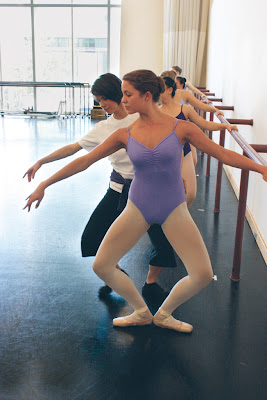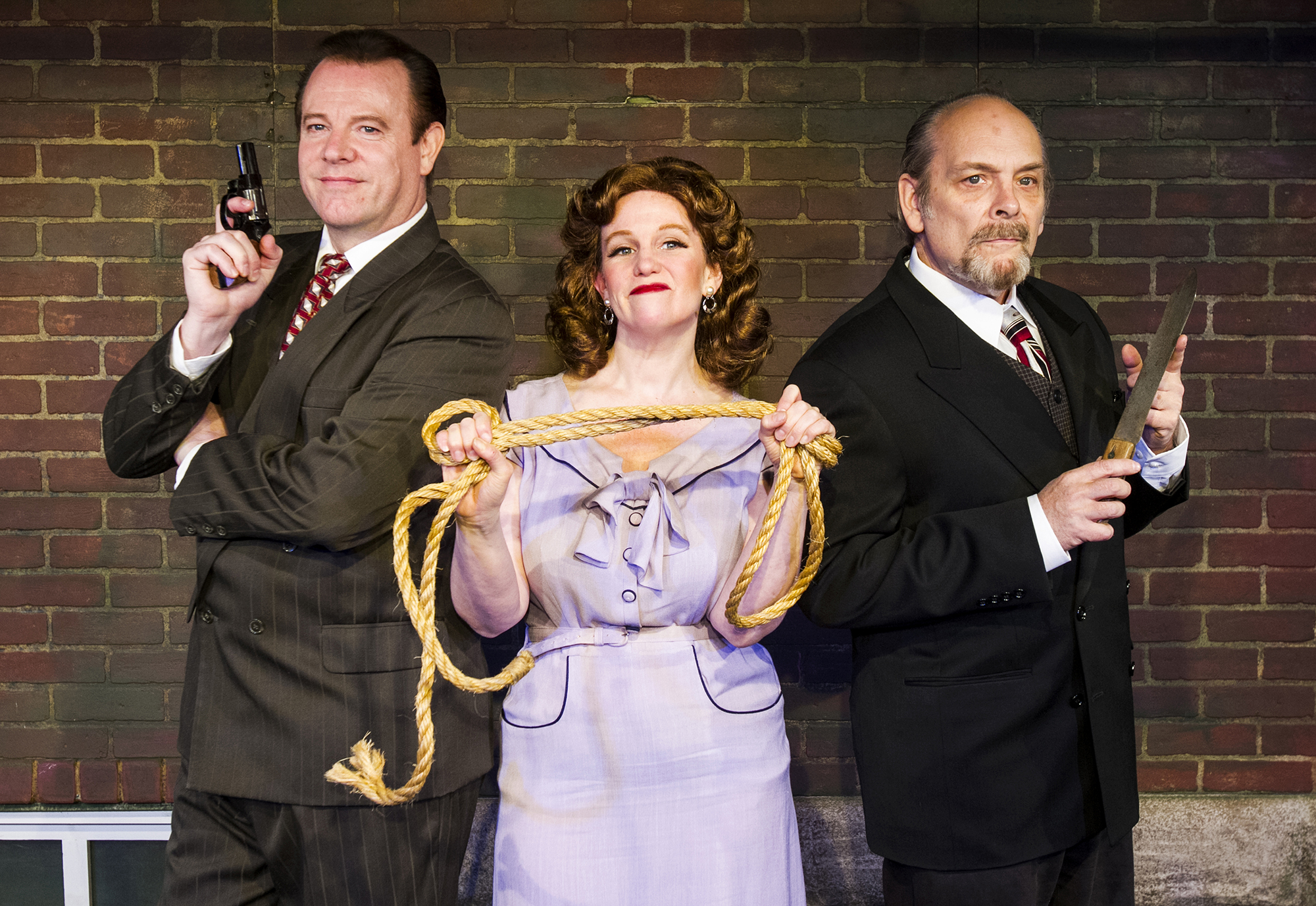Interview by Scott Dowd.
Entire contents copyright ©2012, Fearless Designs, Inc. All rights reserved.
When Elena (Fillmore) Diehl joined the Louisville Ballet as a dancer in the late 1990s, she had no idea that one day she would be coordinating movement and wellness classes for new mothers and octogenarians. Fourteen years later as director of the Louisville Ballet School, Elena (married to another former dancer – Jeff Diehl) is happily teaching classes with the assistance of daughter Ellie. I sat down with Elena at the Ballet’s Main Street headquarters just hours before the beginning of the school’s fall semester.
 |
| Elena with a student at Louisville Ballet School. Photo by Leah Dienes. |
SD: How did you come to this position?
ED: Elizabeth Hartwell was the former director of the school and I served as the school administrator. When Elizabeth accepted a faculty position at Stephens College in Columbia, Missouri, she and Bruce Simpson encouraged me to step up. We had been building up the school together, and though I had never really envisioned myself in this role, I took it as a natural progression.
SD: Like Elizabeth, you were also a dancer with the company.
ED: Just for three seasons. I was here from 1998 to 2001.
SD: Where did you go from here?
ED: I went back to finish my master’s degree in theatre with a dance emphasis at the University of Arizona in Tucson. After that I danced another season with Ballet Met Columbus in Ohio.
SD: What brought you back to Louisville?
ED: I still had connections and friends in Louisville who pulled me back once I was ready to retire as a dancer. There were a lot of opportunities for me here, including the chance to work with the school.
SD: How long have you been the director of the school?
ED: This will be my fifth season.
SD: When did you become interested in teaching dance?
ED: I have always wanted to teach. I recognized I had that passion when I was in college.
SD: Do you have a degree in education?
ED: No, I have a B.F.A. in music – because dance was part of the school of music at that time and my M.F.A. is in theatre. Of course, within those degrees are courses that cover arts administration, choreography and teaching, as well as performance.
 |
| Elena Diehl with students at Louisville Ballet School. Photo by Leah Dienes. |
SD: When people hear “Louisville Ballet School,” I’m sure many images pop into their heads – from little girls in tutus to young people studying to become professional dancers. What is the reality?
ED: We actually work with every age group. I think the common understanding of what we do here is to provide ballet classes for children. While that is certainly a big part of what we do, it is by no means the only thing we do. I have come to understand movement as a language with a vocabulary with which anyone can express himself or herself. It is an innate human characteristic. We actually have neonatal classes for mothers-to-be. We then teach classes, called Dance Together, for caregivers and their children.
SD: How old do the children have to be for that class?
ED: As soon as mom, or the caregiver, feels comfortable wearing the baby in a carrier and moving with them, they are ready. There was an interesting study in 2010 that looked at the experiences of very young children and their reaction to music. The researchers found that the infants responded with more smiles to moving with the rhythm of music than any other stimuli.
SD: What does that research mean to you?
ED: Babies have been moving in utero and they enjoy moving, so why not encourage that during the early stages of development? Music and movement ought to be a part of their daily lives. The classes we offer help to develop that sense of awareness of their bodies and of their bodies in space. It gives them more confidence in the abilities they need to become self-actualized individuals.
SD: I agree that it is innate, but pretty quickly people begin to judge your abilities.
ED: That is why this school’s philosophy for children in those classes is totally nonjudgmental. Our Creative Movement and pre-ballet classes allow children to explore the joy of movement. We focus on imaginative play and creative expression. We are trying to encourage a love of dance.
SD: You have a fifteen-month-old daughter. Is she participating in any of these classes?
ED: Yes. I taught all through my pregnancy, and when we came back last fall, I had Ellie in a baby carrier so she could ride along with me while I was teaching classes. She actually helped me as I created my Dance Together class – she helped me set realistic goals.
SD: How many people are in the classes now? How many can you accommodate?
ED: Last week we had six moms and their babies. That’s a nice-sized class, but we could have more people. Our studios would probably accommodate 15 or 18 caregivers and their little ones. The next step up from that is where the kids get out on the floor. We could accommodate the same number of people, but there is more chasing with the waddlers and toddlers.
SD: Do dancers from the company teach these classes?
ED: We have a large faculty, because most of our instructors have full-time jobs. I think it is really special when we do have dancers from the company because it allows the children to see them on stage and experience them in a new way.
SD: At what age do you begin teaching ballet?
ED: We start teaching ballet technique in the Beginning Ballet class for ages 6 to 8. We don’t ask the children younger than that to do much turn out (rotating from the hips and pointing the toes out to the side) because they’re not capable of holding that position safely. They can do it physically, but they haven’t made the mind-body connections necessary to control it. Even at that, we look at the individual because not all six-year-olds are ready yet.
SD: If they are ready, what kinds of exercises will you do?
ED: We start work at the barre, laying the basic building blocks – turning the legs out and working in first and second positions.
SD: How important is it to begin early for someone who may want to be a professional dancer? I know that dancers’ feet and legs develop differently, but can you begin ballet later in life?
ED: I agree that there are benefits to starting early, but there are also some benefits to starting a little later. Your body definitely adapts at an older age. But when you are older, it is harder to learn the language. I actually didn’t begin taking classes until I was thirteen.
SD: I know a lot of male dancers don’t start dancing until they are eighteen or nineteen.
ED: Even college age is not uncommon for men. Young female dancers who begin in a track like ours where the training guides them to the next level of proficiency will be getting their first pointe shoes at about twelve years old. Their bones are generally ready by that age, but they have also acquired the knowledge base and gained the control, strength and flexibility they need to put on those shoes safely. At that point, they are then ready to take their dancing and training to another level.
SD: Even then you have to wait for complete ossification before they can safely execute some of the moves adult dancers do.
ED: Absolutely. If there is ever a question, we recommend the parent take the child in to the pediatrician to be checked.
SD: So – pardon the expression – this is not Dance Moms?
ED: Noooo! No it’s not! I can’t watch that show – it makes me angry and then sad.
SD: The reason I bring it up is that I think some people believe that is the way dance classes are, or must be.
ED: It is not what dance school has to be like. Unfortunately, it is what some dance schools are really like. That has not been my experience, but I have heard from other dancers who did experience that in their childhood. I was just having a conversation with one of the trainees in this company about that very thing. She grew up in a school like that. It was difficult for her to break out and move into ballet – a style for which she had a real passion.
SD: But this is the Louisville “Ballet” School. Do you teach any other styles of dance?
ED: We actually do. We teach high level Modern Dance technique; we teach tap, jazz dance, musical theatre; and Ben Needham-Wood, a member of our company, teaches hip-hop classes. He brings a really diverse background to share with our kids. I feel proud that the style he teaches veers away from the hip-thrusting, dirty dancing style; his is very intricate and demanding in that you have to isolate and control parts of your body.
SD: Bruce Simpson, the artistic director, has really blurred the lines in the main stage presentations through his choices in choreographers. A lot of them move outside the classical ballet repertoire.
ED: I think ninety-nine percent of the ballet companies in the United States are looking for that kind of diversity in their repertoire. I think our training is to prepare students for those types of companies. Kids also love to do what they see on television, so we give them that vocabulary at a pretty high level. We want to have an inclusive environment for our dancers that allows them to experience as many of the dance/movement styles as we can offer.
SD: Once a student has mastered pointe, you said they can take it to the next level. What level is that?
ED: Older, more advanced dancers in our professional training track may audition for the The Louisville Ballet Youth Ensemble. Through that, they have an opportunity to try their hand at choreography, have ballets choreographed for them and perform at their own concert. They can also participate in a festival called SERBA, the Southeastern Regional Ballet Association.
SD: Do those students perform with the Louisville Ballet?
ED: By the time they are in the Youth Ensemble, they have probably all performed in The Nutcracker for several years.
SD: How many dancers are in the Youth Ensemble?
ED: They audition every fall, so we just did that; and we have twenty-seven dancers in three divisions. The Juniors have one dance they work on for the whole year. They learn how to behave in rehearsal and how that is different from class. We work on getting better and more consistent each week. The Apprentice level dancers understudy many different roles and have an opportunity to perform in some of them. Their main responsibility is to learn how to take in a lot of information and go from one rehearsal to another while retaining all of it. It’s a huge skill to be able to leave a piece, work on several others, and pick up where you left off the next week. At the Senior level, they are doing the most dancing on stage.
SD: At that point they are probably looking at college or some professional experience. If they choose not to become a professional, what is available to them in terms of dance classes?
ED: We have the Adult division. There is a real diversity within that group. We have those students who came up through the school but are not, for whatever reason, dancing elsewhere but want to stay in shape. They come because they know they will get good, challenging classes here. You would probably expect these dancers to be here, because that is what they do. But we also have those people you would not expect – dancers who perhaps took class for a year or two when they were children. Now they are twenty-five or thirty, but they remember loving to dance and want to try it again. They always think they are alone until they get here. We also have people who want the exercise but have never danced and think moving with the music will do for them what other exercise programs can’t.
SD: What about a 51-year-old ex-wrestler with a bad knee?
ED: We have those! Obviously, if you have any kind of athletic background you have a pretty high level of body awareness, strength, control. Those people need another avenue to help their bodies heal or gain different kinds of coordination. We are so excited to have those dancers come in because they already have some kind of vocabulary, even if it isn’t dance-specific. They ask the questions I don’t think to address preemptively because it is such a part of who I am. But they ask great questions about why we do things a certain way, and that benefits the whole class.
SD: We have established that dancers can actually begin during the prenatal period with Mom’s cooperation. On the other end of the spectrum, how long can you continue to safely take these classes?
ED: If you can get up and feel that you have the energy to do barre work, or participate in whatever the style is, e.g. Zumba or flamenco, you can take the class. I think our most mature dancer at the moment is about eighty years old.
SD: There are great benefits for people who keep moving.
ED: Clark Reid, who was a principal dancer here for a number of years, was involved with Dancing Wheels from Cleveland. He brought a program to Louisville and had a Dancing Wheels class at the Louisville Ballet School. Over the years, that has grown into what we call Dance Access. Mark Morris has a program for Parkinson’s dancers up in Brooklyn called Dance for PD®. I would love to become a certified teacher and do that. My hope is that we will be able to offer those kinds of opportunities here. As I said earlier, the Louisville Ballet School conjures this image of a little girl in pink tights, and we certainly do that. But Bruce Simpson and I look at this school very differently. We see the school as not only a center for dance education but, more importantly, as a center for health and wellness that can benefit every level of student. You don’t have to be a “dancer” – if you sway in the kitchen while you’re making dinner or listen to music while you work, you have all the skill you need. I believe the path to health and wellness begins with doing something that brings you joy.
The Louisville Ballet School offers youth programs in the fall and spring that begin after school hours and coincide with the JCPS calendar. Adult programs run year round and begin around 6 p.m. For specific information, go to www.louisvilleballet.org or call Elena Diehl at 502.583.3150.




